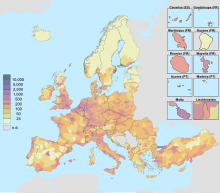| Demographics of the European Union | |
|---|---|
 Map showing the population density by NUTS3 region, 2017, including non-EU countries | |
| Population | 449,206,579 (2024)[1] |
| Growth rate | 0.43% (2023)[1] |
| Birth rate | 8.7 births per 1,000 (2022)[2] |
| Death rate | 11.5 deaths per 1,000 (2022)[3] |
| Life expectancy | 81.5 (2023)[4] |
| • male | 77.9 years (2022)[4] |
| • female | 83.3 years (2022)[4] |
| Fertility rate | 1.46 children per woman (2022) |
| Infant mortality rate | 3.3 deaths per 1,000 live births (2022)[5] |
| Language | |
| Official | See languages of the European Union |
| Spoken | Most spoken L1: German: 20% (2020)
Most spoken L2: English L2: 43% (2017)[6][7] [8] |



The demographics of the European Union show a highly populated, culturally diverse union of 27 member states. As of 1 January 2024, the population of the EU is around 449 million people.[1]
- ^ a b c "Population on 1 January". Eurostat. Retrieved 27 March 2024.
- ^ "Live births and crude birth rate". Eurostat.
- ^ "Deaths and crude death rate". Eurostat.
- ^ a b c "Life expectancy at birth by sex". Eurostat.
- ^ "Infant Mortality rate". Eurostat.
- ^ Cite error: The named reference
Wileywas invoked but never defined (see the help page). - ^ "Despite Brexit, English Remains The EU's Most Spoken Language By Far". Forbes.
- ^ "Eurobarometer" (PDF). Archived from the original (PDF) on 6 January 2016.